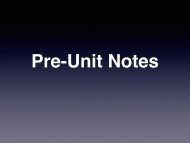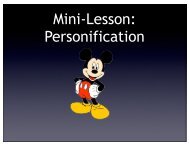Unit 2 Non-Fiction
m9qwmun
m9qwmun
You also want an ePaper? Increase the reach of your titles
YUMPU automatically turns print PDFs into web optimized ePapers that Google loves.
Mini-Lesson<br />
<strong>Unit</strong> 2: <strong>Non</strong>-<strong>Fiction</strong>
<strong>Fiction</strong><br />
• is prose writing that tells about<br />
imaginary characters and events.
<strong>Non</strong>-<strong>Fiction</strong><br />
• is prose writing that presents and explains<br />
ideas or that tells about real people,<br />
places, ideas, or events
ELEMENTS OF<br />
*<br />
NON-FICTION<br />
• TONE: expresses an author’s attitude<br />
toward the subject and the readers. It is<br />
conveyed through choice of words and<br />
details<br />
• PERSPECTIVE: is the author’s point of<br />
view on the subject, including the opinions<br />
that the author expresses and the source of<br />
the author’s information
PURPOSES OF<br />
*<br />
NON-FICTION<br />
• to PERSUADE the reader<br />
• to INFORM the reader of something<br />
• to ENTERTAIN/HUMOR the reader<br />
• to CALL the reader TO take ACTION<br />
• to DESCRIBE something to the reader
Thesis Statement<br />
*<br />
Definition: A thesis statement controls the<br />
subject matter of the essay and states<br />
something significant to the reader. It is the<br />
one statement that summarizes the main<br />
point of the essay and states why the essay is<br />
important and worth reading.<br />
TOPIC + OPINION = THESIS
Tone & Mood<br />
*<br />
Tone and mood are NOT the same. The<br />
tone of a piece of literature is the<br />
speaker’s or narrator’s attitude towards<br />
the subject or reader, rather than what<br />
the reader feels, as in mood which is the<br />
general feeling or atmosphere that a piece<br />
of writing creates within the reader.
Tone<br />
Definition: Tone is the attitude(s) toward<br />
the subject and/or audience implied in a<br />
literary work. Each piece of literature has<br />
at least one theme (central idea or<br />
message), the central question about a<br />
topic, and how the theme is approached<br />
within the work is known as the tone.<br />
*<br />
Example: A love letter to your high school crush might<br />
have playful, sweet, and romantic tone, but a letter to<br />
end the relationship with a significant other after having<br />
found out that they were cheating on you behind your<br />
back will have an serious, hateful, and angry tone.
Mood<br />
Definition: Mood is an element in the narrative<br />
structure of a piece of literature that can also be<br />
referred to as atmosphere because it creates an<br />
emotional setting for the reader. Mood is established<br />
in order to affect the reader emotionally,<br />
psychologically, and to provide a feeling for the<br />
narrative.<br />
*<br />
Example: A love letter from a high school sweetheart<br />
will evoke a warm and loving mood in the reader, but a<br />
Facebook posting by a bully will bring forth a gloomy,<br />
hopeless, uneasy, anxious, worried mood in the reader.
Development of Mood<br />
*<br />
Mood is produced most effectively through<br />
the use of:<br />
• SETTING<br />
• THEME<br />
• VOICE<br />
• TONE
Literal Language<br />
*<br />
Definition: Refers to words that do<br />
not deviate from their defined<br />
meaning. A literal usage is the<br />
“normal” meanings of the words.<br />
Literal language means exactly what<br />
it says.
Figurative Language *<br />
Definition: Refers to words, and groups of<br />
words, that exaggerate or alter the usual<br />
meanings of the component words for effect.<br />
Figurative language is the opposite of literal<br />
language and means something different to (and<br />
usually more than) what it says on the surface.<br />
Example:<br />
He ran fast. (literal)<br />
He ran like the wind. (figurative)
Rhetoric<br />
*<br />
Definition: The art of written and<br />
spoken communications, an art that<br />
aims to improve the capability of<br />
writers or speakers that attempt to<br />
inform, persuade, or motivate<br />
particular audiences in specific<br />
situations.
Rhetorical Devices<br />
*<br />
Definition: A technique that an<br />
author or speaker uses to convey to<br />
the reader or listener a meaning<br />
with the goal of persuading him<br />
towards considering a topic from a<br />
different perspective.
Types of Rhetorical Devices<br />
• Rhetorical Question<br />
• Repetition<br />
• Anecdote<br />
• Parallel Structure<br />
• Imagery<br />
• Irony<br />
*
Rhetorical Question<br />
*<br />
A figure of speech in the form of a<br />
question that is asked in order to<br />
make a point. The question is posed<br />
not to create a specific answer from<br />
the reader or audience, but rather<br />
encourage them to consider a<br />
message or viewpoint.
*<br />
Repetition<br />
The reuse of the same words,<br />
phrases, or ideas for rhetorical effect,<br />
usually to emphasize a point.
Anecdote<br />
*<br />
A brief narrative of an interesting or<br />
amusing incident, often intended to<br />
illustrate an idea or make a point.
Parallel Structure<br />
*<br />
The balance within one or more<br />
sentences of similar phrases or<br />
clauses that have the same<br />
grammatical structure.<br />
Example:<br />
“... and that government of the people, by<br />
the people, for the people, shall not<br />
perish from the earth.”<br />
-Abraham Lincoln, Gettysburg Address
Imagery<br />
*<br />
A word or phrase representing that<br />
which can be seen, touched, tasted,<br />
smelled, or heard.<br />
Example:<br />
Sound imagery: He stepped softly onto<br />
the creaking floor to avoid waking up his<br />
parents.
*<br />
Irony<br />
The use of words to express<br />
something different from and often<br />
opposite to their literal meaning.
Types of Irony<br />
*<br />
• Verbal Irony<br />
• Dramatic Irony<br />
• Situational Irony
Verbal Irony<br />
*<br />
Definition: A specific type of irony in<br />
which a person says one thing and<br />
means another, or uses words to<br />
convey a meaning that is opposite of<br />
the literal meaning.
Dramatic Irony<br />
*<br />
Definition: This type of irony gives the<br />
reader or audience an item of information<br />
that at least one of the characters in the<br />
narrative is unaware of, thus placing the<br />
spectator a step ahead of at least one of the<br />
characters.<br />
Example:<br />
Juliet is not actually dead when Romeo sees her<br />
in the tomb in Shakespeare’s The Tragedy of Romeo<br />
& Juliet
Situational Irony<br />
*<br />
Definition: A situation where the<br />
outcome is incongruous (out of place)<br />
with what was expected.<br />
Example: The ending of “Contents of<br />
the Dead Man’s Pocket.”
*<br />
WRITING STYLES<br />
Formal vs. Informal
Informal Tone Writing Style *<br />
• NOT allowed for academic work in this class, unless<br />
told otherwise by Mr. Allice or a question directly<br />
asks you about something.<br />
• Allows the use of 1st & 2nd person point of view:<br />
Pronouns “I” , “me” , “my” , “you” , “your” , “us” &<br />
“we”.<br />
• Contractions and abbreviations of words are allowed<br />
to be used.<br />
• Use of conversational words or “text talk” is okay<br />
(e.g. kids, a lot, well, lol, omg, brb).
Formal Tone Writing Style *<br />
A formal tone writing style helps establish the<br />
writer's respect for the audience and suggests that<br />
the writer is serious about his or her topic. It is the<br />
kind of tone that educated people use when<br />
communicating with other educated people. Most<br />
academic writing uses a formal tone.





